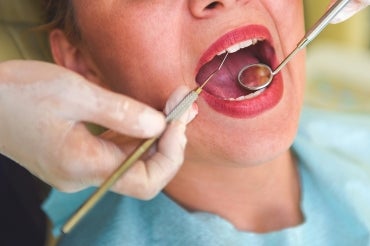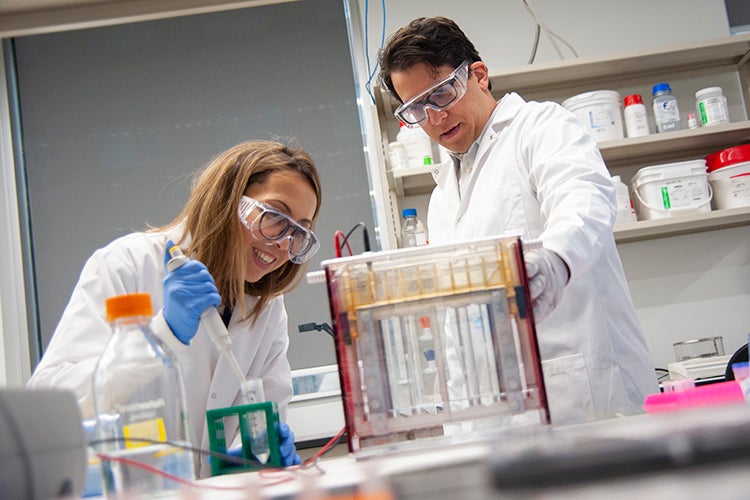Ontario dentists playing bigger role in oral cancer detection: U of T study

Published: May 2, 2019
After examining data gathered in a first-of-its-kind provincial study, University of Toronto clinician-scientist Marco Magalhaes has a vital message to convey: Dentists in Ontario are detecting more cases of oral cancer and pre-cancer than ever before – and it’s saving lives.
The study, published in the Journal of the American Dental Association, looked at 63,483 biopsies submitted to the service between 2005 and 2015.
“We wanted to look at the scope of oral biopsies performed by dentists, what they’re seeing in practice,” says Magalhaes, who is an assistant professor at U of T's Faculty of Dentistry and one of the oral pathologists at the Toronto Oral Pathology Service, or TOPS.
Operated by the Faculty of Dentistry, TOPS is one of the largest oral pathology services in Canada and provides comprehensive evaluation of biopsy specimens – the overwhelming majority of which are submitted by dentists.
For the study, researchers compared biopsy data from TOPS to numbers collected by the Ontario cancer registry, Cancer Care Ontario, which tracks all reported cancers in the province. The data showed a steep rise in the overall numbers of oral squamous cell carcinoma (oral cancers) and oral epithelial dysplasia (pre-cancerous lesions) detected by dentists.
Overall, 828 cases of oral cancer were diagnosed by the U of T oral pathology service between 2005 to 2015, along with 2,679 premalignant lesions. But over time, the percentage of oral cancer detection by oral health professionals rose significantly. In 2005, only 56 cases of oral cancer and 99 cases of oral epithelial dysplasia were detected through biopsy.
By 2015, though, the number of oral cancers detected through the biopsy service had nearly doubled, rising to 103 cases. Dysplasia cases, meanwhile, more than tripled from 2005, rising to 374.

Marco Magalhaes (right) with research associate Denise Lopes Eymael (photo by Jeff Comber)
“These numbers are important because the number of diagnosed cases outpaced both the rise in population in Ontario and the increased number of dentists licensed in Ontario,” says Magalhaes, the study’s lead author.
In fact, the increase in the number of cases detected at TOPS was significantly higher – 180 per cent – than the overall increase of oral cancers recorded in the province over that same period, which was just 30 per cent. Cancer Care Ontario identified a total of 9,045 cases of oral cancer between 2005 and 2015.
More comprehensive training and continuing education programs for oral health professionals may be behind the dramatic rise in detection rates. While advanced oral cancers are fairly easy to detect, Magalhaes says pre-malignant lesions and early cancer can be easy to miss without specialized training.
Calling the TOPS service “extraordinary,” Michael Glogauer, interim chief dentist at the Princess Margaret Cancer Centre and professor at U of T’s Faculty of Dentistry, agrees that strong training is likely playing a role in the higher detection rates.
“The focus on oral cancer education through the universities and continuing education in the area of cancer has led to the increased surveillance by dentists, and validates the focus that the dentists in this province are placing on this important health initiative,” says Glogauer.
Researchers may also be learning to pinpoint which – and how many – pre-cancerous lesions will, over time, turn cancerous. While the study provides evidence that TOPS was involved in the diagnosis of approximately 10 per cent of all oral cancers in the province, it also demonstrated a dramatic increase in the number of pre-cancerous lesions identified by these health-care providers.
That’s important because the provincial cancer agency does not keep statistical data on precancerous lesions, making the TOPS biopsy data especially relevant in the hunt to discover which premalignant lesions will become cancers.
“This is the first time that we have assessed dysplasia detected by dentists over such a long period of time,” says Magalhaes.
Oral cancer survival rates have remained steady over the past several decades. What that means, says Magalhaes, is that “advancements in treatment have minimally improved survival rates,” which are about 30 per cent over five years if the cancer is detected at an advanced stage. Yet, treated in its early stages, patients with oral cancer have among the highest survival rates – around 80 per cent over five years.
“This supports the fact that early detection really is the most important step here,” Magalhaes says.



